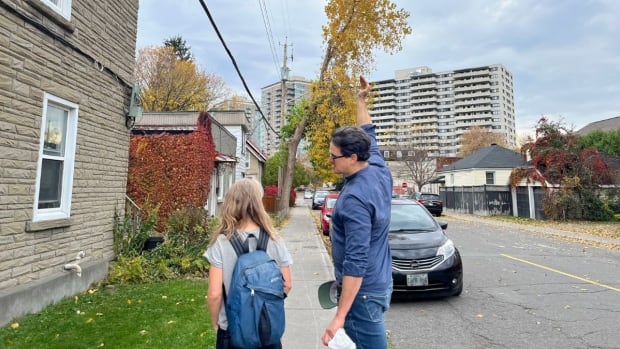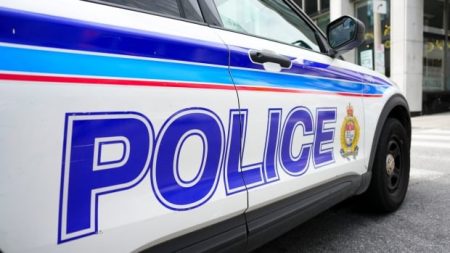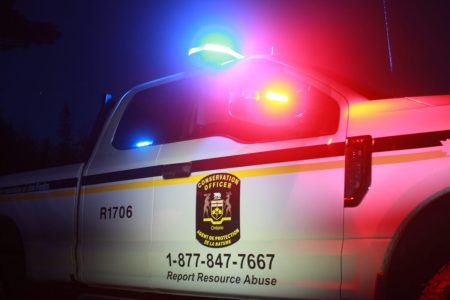Forestry researchers Erin Whittingham, left, and Camilo Ordonez took a stroll with CBC Ottawa’s Robyn Bresnahan to clarify what’s so necessary about tree fairness. (Robyn Bresnahan/CBC)
In its new 20-year city forestry administration plan, the Metropolis of Ottawa has dedicated to fight a rising drawback: tree inequity.
Most Canadian neighbourhoods with decrease incomes and extra racialized residents even have fewer timber than their wealthier counterparts, in response to analysis by Nature Canada and American Forests.
Ottawa is not any exception. Town’s official aim is for 40 per cent of all area to be lined with tree cover.
However within the extremely numerous downtown Somerset Ward, it is simply 22 per cent.
“We began to appreciate if we drill right down to the place the areas of low cover cowl are, it tends to be in areas that home equity-deserving communities,” stated Martha Copestake, the town’s senior planning forester.
For the primary time ever, the Metropolis of Ottawa is calculating its personal “tree fairness rating,” which can permit it to pinpoint precisely which communities want help probably the most.
Timber are an ‘unbelievable know-how’
The advantages that folks get from timber are “actually limitless,” stated Erin Whittingham, a reforestation organizer at Nature Canada.
Folks ready for a bus might have appreciated the shade of a tree on a sizzling afternoon, for instance. Holding cities cool with timber as temperatures rise is necessary for “constructing warmth resilient cities,” Whittingham defined.
However she stated timber additionally enhance our immune system, present habitat for animals, develop fruit or nuts, cut back the chance of flooding, and enhance psychological well being in the neighborhood.
“The way in which I actually like to consider tree fairness is considering timber as this unbelievable piece of know-how that may actually assist us make our cities extra fulfilling,” she stated.
“They’ll make our cities safer. They’ll make folks happier. However proper now this piece of know-how is barely out there in sure neighbourhoods.”
Whittingham and Ordóñez each agree that extra timber can enhance the group’s high quality of life. ‘You understand how timber make us really feel after we stroll down the road,’ Ordóñez stated. (Robyn Bresnahan/CBC)
What is going to Ottawa do about it?
In Ottawa, pure disasters like windstorms and the 2022 derecho have underlined the pressing have to replant.
However Camilo Ordóñez, a funding advisor on the Federation of Canadian Municipalities, defined that the disparity between Ottawa neighbourhoods is an issue with deep roots.
The Glebe and New Edinburgh have loads of timber, he stated, as a result of they’re older neighbourhoods and the timber are well-established. There aren’t lots of timber in newer, car-focused areas like round Merivale Highway and components of Alta Vista, which additionally are typically extra numerous, he stated.
Whittingham stated many landlords “see timber as a burden” due to the upkeep prices, so the cover might be scarce in neighbourhoods with a number of rental models.
“Within the [city] I stay in, Gatineau, you possibly can clearly see properties which might be the low-rise walkups and so they’re all concrete,” Whittingham stated. “[There’s] no incentive or requirement from the town to have timber on these non-public properties.”
Tree cowl is ‘one of many key parts that makes the town livable,’ stated Martha Copestake, the senior planning forester for the Metropolis of Ottawa. (Robyn Bresnahan/CBC)
Ottawa’s “tree fairness rating” — based mostly on tree cover cowl and socio-economic knowledge — will present which neighbourhoods want probably the most help. Copestake stated they have been impressed by related work in Toronto.
Ottawa makes use of packages like Timber in Belief to encourage tree-planting.
The packages are well-liked in prosperous areas however not in low-income neighbourhoods, Copestake stated, although that is the place they’re most wanted.
“We [manage the urban canopy] in a extra reactive means than proactive means,” Copestake stated. “That mannequin of program supply might not work as properly for these neighbourhoods.”
The tree fairness rating is predicted within the spring of 2025. As soon as it has pinpointed high-priority neighbourhoods, the town plans to attach with their group members and take steps to plant timber.









